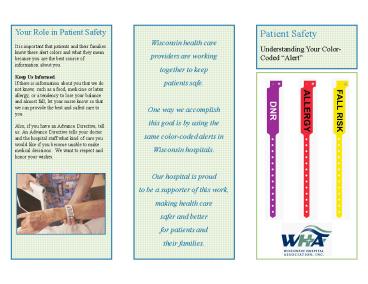Your Role in Patient Safety - PowerPoint PPT Presentation
1 / 2
Title:
Your Role in Patient Safety
Description:
Your Role in Patient Safety It is important that patients and their families know these alert colors and what they mean because you are the best source of information ... – PowerPoint PPT presentation
Number of Views:34
Avg rating:3.0/5.0
Title: Your Role in Patient Safety
1
Your Role in Patient Safety It is important that
patients and their families know these alert
colors and what they mean because you are the
best source of information about you. Keep Us
Informed. If there is information about you that
we do not know, such as a food, medicine or latex
allergy, or a tendency to lose your balance and
almost fall, let your nurse know so that we can
provide the best and safest care to you.
Also, if you have an Advance Directive, tell
us. An Advance Directive tells your doctor and
the hospital staff what kind of care you would
like if you become unable to make medical
decisions. We want to respect and honor your
wishes.
Wisconsin health care providers are working
together to keep patients safe. One way we
accomplish this goal is by using the same
color-coded alerts in Wisconsin hospitals. Our
hospital is proud to be a supporter of this
work, making health care safer and better for
patients and their families.
Patient Safety Understanding Your Color-Coded
Alert
2
Statewide Patient Safety Initiative Patient
safety is a top priority for Wisconsin hospitals.
We accomplish this in several ways, one which
includes using the same colors for alerts.
What is a color-coded alert? Color-coded
alerts including wristbands, stickers and plaques
are used in hospitals to quickly communicate a
special health care condition or a safety risk
that a patient may have. This is done so every
staff member can provide the best care
possible. Each colors have a different meaning.
The words for the alerts are also written on the
alert to reduce confusion. State-wide
Wristbands Wisconsin uses two state-wide
wristbands in health care that may apply to
you. Multiple Victim tracking wristband -
Applied by emergency service workers to track
patients when five or more patient are involved
in the same accident. State of Wisconsin Do Not
Resuscitate (DNR) bracelet - Indicates a
patients wishes to not receive CPR in the
community. This order does not apply to your
hospital stay and must be re-evaluated at
admission to the hospital
What do the difference colors mean?
There are three different color-coded alerts that have been standardized throughout hospitals. These color coded alerts include
Purple means Do Not Resuscitate (DNR)
Some patients have expressed an end-of-life wish and we want to honor that request.
Red means Allergy
If you have an allergy to anything food, medicine, dust, grass, pet hair, ANYTHINGtell us. It may not seem important to you but it could be very important to your care.
Yellow means Fall Risk
We want to prevent falls at all times. Nurses review patients to determine if you need help when getting up or walking. Sometimes, a patient may become weak or confused during their illness. When you have this color-coded alert, all staff will know that you need help to prevent a fall.































